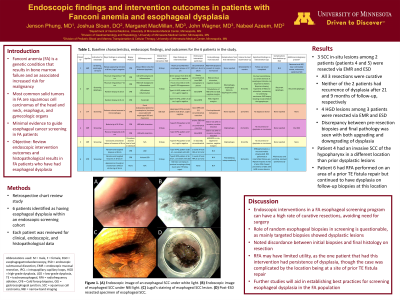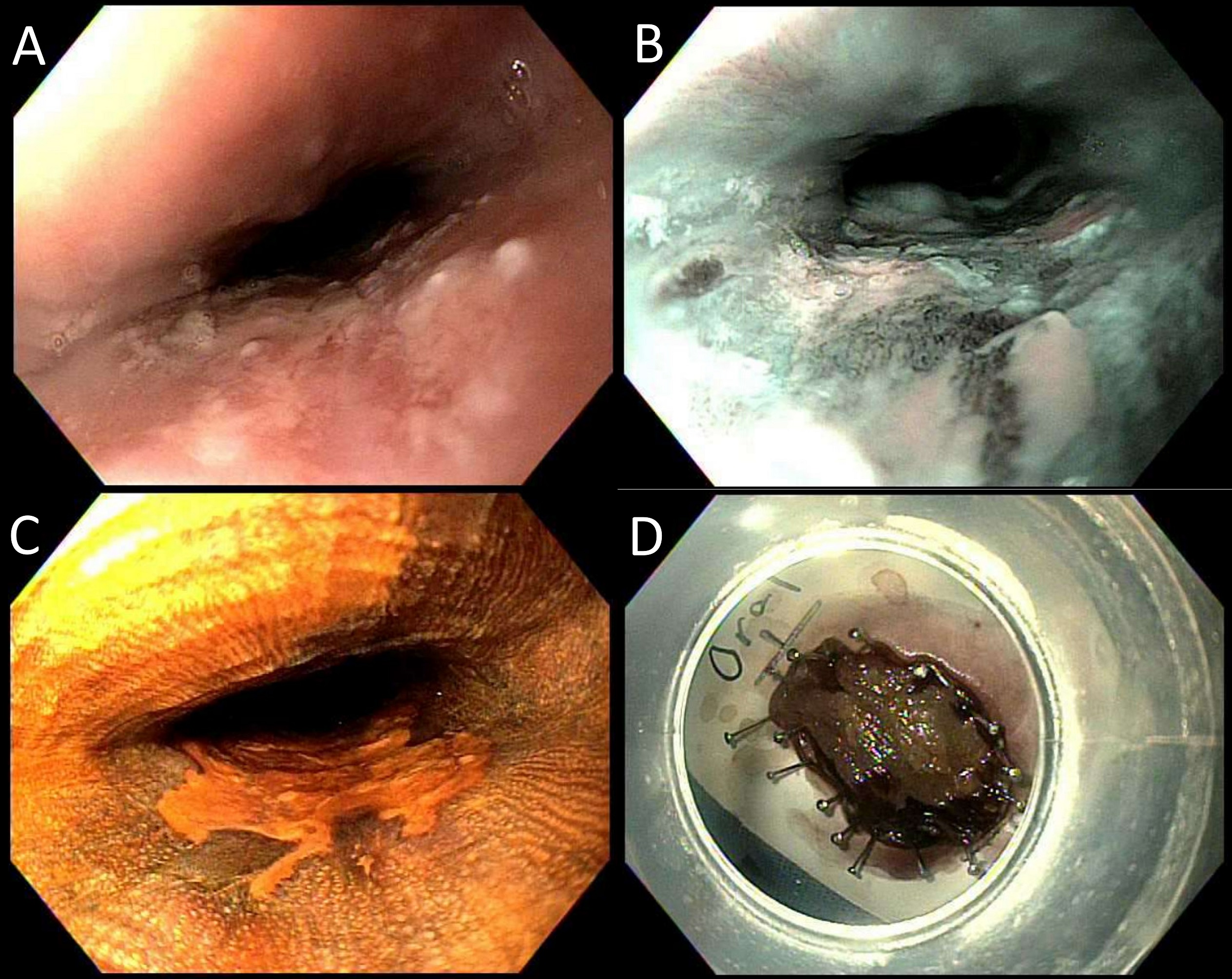Tuesday Poster Session
Category: Esophagus
P3923 - Endoscopic Findings and Intervention Outcomes in Patients With Fanconi Anemia and Esophageal Dysplasia
Tuesday, October 29, 2024
10:30 AM - 4:00 PM ET
Location: Exhibit Hall E

Has Audio

Jenson Phung, MD
University of Minnesota
Minneapolis, MN
Presenting Author(s)
Jenson Phung, MD1, Joshua A. Sloan, DO1, Margaret MacMillan, MD, MSc1, John Wagner, MD1, Nabeel Azeem, MD2
1University of Minnesota, Minneapolis, MN; 2University of Minnesota Medical Center, Minneapolis, MN
Introduction: Fanconi anemia (FA) is a genetic condition signified by bone marrow failure and is associated with an increased risk for malignancy, with the most common solid carcinomas being squamous cell carcinomas of the head and neck, esophagus, and gynecologic organs. Despite the increased risk of esophageal squamous cell carcinoma (SCC) in FA patients, there is currently minimal data to guide screening, and outcomes of endoscopic intervention within a screened population have not been investigated.
Methods: Within an endoscopic screening cohort, 6 patients with FA were identified with esophageal dysplasia. Retrospective chart review was performed to determine the outcomes of endoscopic interventions.
Results: Baseline data and endoscopic interventions with follow-up data are displayed in Table 1. A total of 3 SCC in-situ lesions among 2 patients, patients 4 and 5, were resected via endoscopic mucosal resection (EMR) and endoscopic submucosal dissection (ESD). All 3 resections were curative. Neither patient 4 nor patient 5 had recurrence of dysplasia after 21 and 9 months of follow-up, respectively. Four high grade dysplasia (HGD) lesions among 3 patients were resected via EMR and ESD. Discrepancy between pre-resection biopsies and final pathology was seen in patients 1, 2, and 4 with both upgrading and downgrading of dysplasia. Patient 4 developed invasive SCC of the hypopharynx in a different location than her prior dysplastic lesions. Patient 6 had radiofrequency ablation (RFA) performed on dysplastic lesions at the location of a prior tracheoesophageal (TE) fistula repair. Despite multiple rounds of RFA, the patient continued to have dysplasia identified on follow-up biopsies at the same location.
Discussion: This study shows that endoscopic interventions in a FA esophageal screening program can have a high rate of curative resections avoiding surgery. The role of random biopsies in screening is questionable, as mainly targeted biopsies revealed dysplastic lesions. Additionally, final histology on resected specimens often were discordant with initial biopsies. Advanced or invasive SCC was not identified in any of the patients except for a hypopharyngeal lesion identified on endoscopy. RFA may have limited utility, as the one patient it was performed on had persistent low-grade dysplasia, though this case was complicated by the presence of a TE fistula repair at the site of the lesion. Further studies are needed to establish best practices for screening esophageal dysplasia in the FA population.

Note: The table for this abstract can be viewed in the ePoster Gallery section of the ACG 2024 ePoster Site or in The American Journal of Gastroenterology's abstract supplement issue, both of which will be available starting October 27, 2024.
Disclosures:
Jenson Phung, MD1, Joshua A. Sloan, DO1, Margaret MacMillan, MD, MSc1, John Wagner, MD1, Nabeel Azeem, MD2. P3923 - Endoscopic Findings and Intervention Outcomes in Patients With Fanconi Anemia and Esophageal Dysplasia, ACG 2024 Annual Scientific Meeting Abstracts. Philadelphia, PA: American College of Gastroenterology.
1University of Minnesota, Minneapolis, MN; 2University of Minnesota Medical Center, Minneapolis, MN
Introduction: Fanconi anemia (FA) is a genetic condition signified by bone marrow failure and is associated with an increased risk for malignancy, with the most common solid carcinomas being squamous cell carcinomas of the head and neck, esophagus, and gynecologic organs. Despite the increased risk of esophageal squamous cell carcinoma (SCC) in FA patients, there is currently minimal data to guide screening, and outcomes of endoscopic intervention within a screened population have not been investigated.
Methods: Within an endoscopic screening cohort, 6 patients with FA were identified with esophageal dysplasia. Retrospective chart review was performed to determine the outcomes of endoscopic interventions.
Results: Baseline data and endoscopic interventions with follow-up data are displayed in Table 1. A total of 3 SCC in-situ lesions among 2 patients, patients 4 and 5, were resected via endoscopic mucosal resection (EMR) and endoscopic submucosal dissection (ESD). All 3 resections were curative. Neither patient 4 nor patient 5 had recurrence of dysplasia after 21 and 9 months of follow-up, respectively. Four high grade dysplasia (HGD) lesions among 3 patients were resected via EMR and ESD. Discrepancy between pre-resection biopsies and final pathology was seen in patients 1, 2, and 4 with both upgrading and downgrading of dysplasia. Patient 4 developed invasive SCC of the hypopharynx in a different location than her prior dysplastic lesions. Patient 6 had radiofrequency ablation (RFA) performed on dysplastic lesions at the location of a prior tracheoesophageal (TE) fistula repair. Despite multiple rounds of RFA, the patient continued to have dysplasia identified on follow-up biopsies at the same location.
Discussion: This study shows that endoscopic interventions in a FA esophageal screening program can have a high rate of curative resections avoiding surgery. The role of random biopsies in screening is questionable, as mainly targeted biopsies revealed dysplastic lesions. Additionally, final histology on resected specimens often were discordant with initial biopsies. Advanced or invasive SCC was not identified in any of the patients except for a hypopharyngeal lesion identified on endoscopy. RFA may have limited utility, as the one patient it was performed on had persistent low-grade dysplasia, though this case was complicated by the presence of a TE fistula repair at the site of the lesion. Further studies are needed to establish best practices for screening esophageal dysplasia in the FA population.

Figure: Figure 1. (A) Endoscopic image of an esophageal squamous cell carcinoma (SCC) under white light. (B) Endoscopic image of esophageal SCC under narrow band imaging light. (C) Staining with Lugol's solution of esophageal SCC lesion. (D) Resected specimen of esophageal SCC after endoscopic submucosal dissection.
Note: The table for this abstract can be viewed in the ePoster Gallery section of the ACG 2024 ePoster Site or in The American Journal of Gastroenterology's abstract supplement issue, both of which will be available starting October 27, 2024.
Disclosures:
Jenson Phung indicated no relevant financial relationships.
Joshua Sloan: Sanofi-Regeneron – Advisory Committee/Board Member, Speakers Bureau.
Margaret MacMillan indicated no relevant financial relationships.
John Wagner indicated no relevant financial relationships.
Nabeel Azeem: Boston Scientific – Consultant.
Jenson Phung, MD1, Joshua A. Sloan, DO1, Margaret MacMillan, MD, MSc1, John Wagner, MD1, Nabeel Azeem, MD2. P3923 - Endoscopic Findings and Intervention Outcomes in Patients With Fanconi Anemia and Esophageal Dysplasia, ACG 2024 Annual Scientific Meeting Abstracts. Philadelphia, PA: American College of Gastroenterology.
